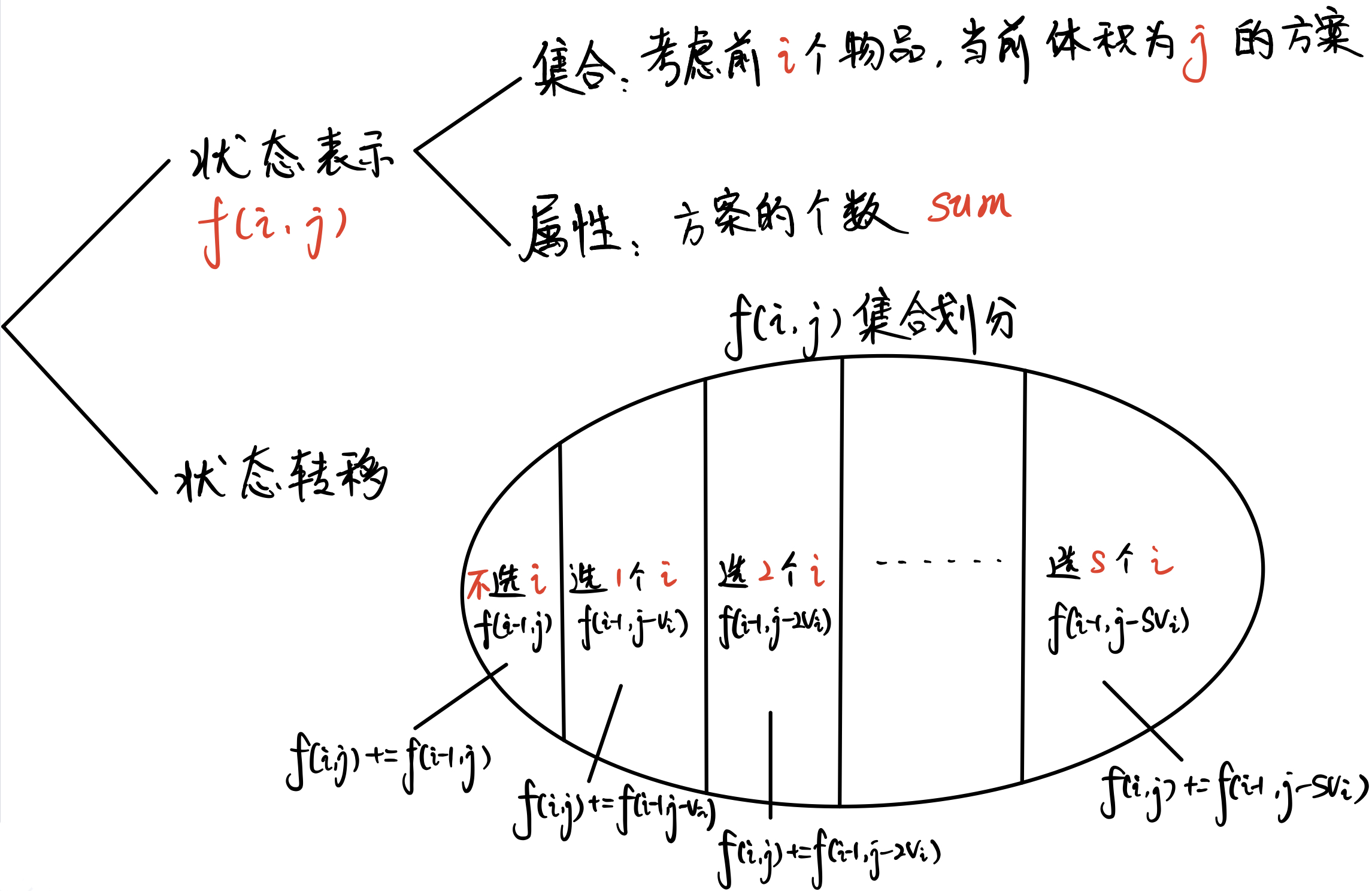You can not select more than 25 topics
Topics must start with a letter or number, can include dashes ('-') and can be up to 35 characters long.
5.1 KiB
5.1 KiB
一、题目描述
小明有 m 块钱,现有 10 元, 20 元, 50 元, 100 元 的书
每本书可以 购买多次,求小明有 多少种 买书 方案
注:钱需要花完
输入格式
一个整数 n,代表总共钱数。
输出格式
一个整数,代表选择方案种数。
数据范围
0≤n≤1000
输入样例1:
20
输出样例1:
2
输入样例2:
15
输出样例2:
0
输入样例3:
0
输出样例3:
1
二、分析
一共有 n 个物品,每个物品有体积 v_i,价值 w_i,每个物品能够选多次
求总体积恰好是m的方案数
这是一道 裸的完全背包问题求解方案数
闫氏DP分析法
状态表示——集合:f[i][j] 表示考虑前i个数字,且总数字和 恰好 j的集合下能获得的方案数。
状态表示——属性:因为是求方案数,故为 count。
状态计算——集合划分:考虑第 i 个数选不选。
- 不选或选不了(剩余数量不够
j<a[i]):f[i−1][j]。 - 选:
f[i][j−a[i]]。
初始状态:f[0][0]
目标状态:f[n][m]

二、朴素版本
时间复杂度:O(n^2 \times m)
#include <bits/stdc++.h>
using namespace std;
const int N = 5;
const int M = 1010;
int v[N] = {0, 10, 20, 50, 100}; // 每种货币,下标从1开始
int n, m; // 货币种类,钱数
int f[N][M]; // 前i种物品,体积恰好是j的情况下的最大值
// 完全背包
int main() {
n = 4;
cin >> m;
// 前0种物品,体积是0的情况下只有一种方案
// 一般询问方案数的问题f[0]都会设置为1
// Q:那20元钱呢?不买;买两本10块的;每一本20的。三种呀
// A:题目说的全部,钱要花完
f[0][0] = 1;
for (int i = 1; i <= n; i++) // 每个物品
for (int j = 0; j <= m; j++) // 每个体积
for (int k = 0; v[i] * k <= j; k++) // 个数
f[i][j] += f[i - 1][j - v[i] * k];
printf("%d\n", f[n][m]);
return 0;
}
三、完全背包—经典优化
使用瞪眼大法,观察 f(i,j) 的 状态转移方程 进行变形
尝试找出f(i,j)与它的前序f(i,j-v_i)之间的关联关系,看看能不能实现f(i,j-v_i)->f(i,j)的迁移:
\large f(i,j)=f(i-1,j)+f(i-1,j-v_i)+...+f(i-1,j-s\cdot v_i)①\large f(i,j-v_i)= f(i-1,j-v_i)+...+f(i-1,j-s\cdot v_i)②注:把体积j-v_i代入①式,就可以得到 ②式
Q:①和②中的s是一个值吗,为什么?
答:是一个值的。原因可以从事情本质出发,思考一下s\cdot v_i的含义是什么:就是在j这么大的空间限制下,最多可以装多少个i物品,当然是同一个个数值s了。
由上述两个等式可以获得如下递推式:
\LARGE f(i,j)=f(i−1,j)+f(i,j−v_i)把这个等式作为 状态转移方程 ,就可以把时间复杂度优化到 O(n \times m)
同时,观察到该 转移方程 对于第 i 阶段的状态,只会使用第 i-1 层和第 i 层的状态
因此我们也可以采用 01背包 的 空间优化方案
时间复杂度:O(n×m)
空间复杂度:O(m)
二维优化版本
#include <bits/stdc++.h>
using namespace std;
const int N = 1010;
int v[5] = {0, 10, 20, 50, 100};
int f[5][N];
int main() {
int m;
cin >> m;
// 前0种物品,体积是0的情况下只有一种方案
f[0][0] = 1;
for (int i = 1; i <= 4; i++)
for (int j = 0; j <= m; j++) {
f[i][j] = f[i - 1][j];
if (v[i] <= j) f[i][j] += f[i][j - v[i]];
}
printf("%d\n", f[4][m]);
return 0;
}
一维优化解法
#include <bits/stdc++.h>
using namespace std;
const int N = 1010;
int v[5] = {0, 10, 20, 50, 100};
int f[N];
// 体积限制是恰好是,因此需要初始化f[0][0]为合法解1,其他位置为非法解0。
int main() {
int m;
cin >> m;
// 前0种物品,体积是0的情况下只有一种方案
f[0] = 1;
for (int i = 1; i <= 4; i++)
for (int j = v[i]; j <= m; j++)
f[j] += f[j - v[i]];
// 输出
printf("%d\n", f[m]);
return 0;
}